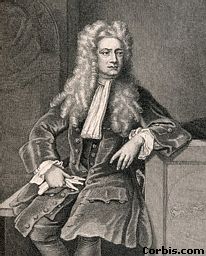
Lesson
Plan:
We will be recalling Newton’s three laws of motion and particularly focusing on Newton’s third law. Many students, including myself, have trouble understanding, grasping and believing the concepts of Newton’s third law. This law is very important, and should be accepted with ease. We experience it in everyday life. Every time we interact with our surroundings we experience this third law. In fact, all moving objects, and stationary objects, experience this law.
Newton’s third law will be demonstrated by several physical collisions between two carts.
Who
is Newton, anyway?!

Sir Isaac Newton was born on Christmas Day in Lincolnshire, England 1642 [the same year of Galileo’s death] and died in London, England 1727. Many people associate Sir Isaac Newton for his discovery of gravity, supposedly as he observed an apple drop from a tree.
Though, Newton is also responsible for laying down the fundamental laws of the physical universe. These are the principles that describe how and why things work the way they do. These principles are known as Newton’s Laws of Motion.
Newton laid out the principles of his laws of motion by building on and merging together the work of his great predecessors- such as Galileo Galilei, Copernicus, and Kepler- all by a very young age [early twenties].
Sir Isaac Newton, the first scientist to have been knighted, was a little ill-tempered, somewhat of a loner, very intelligent, an amazing physicist, an a true genius in mathematics [he discovered the fundamentals for physical optics, theory of gravitation, calculus]. Also very modest, and once said “If I have seen further than other men, it is because I stood on the shoulders of giants.”
Newton’s Laws of Motion:
Newton’s
first law: The Law of Inertia
Newton’s
second law: The Law of Acceleration
Newton’s third law: The Law of Interaction (The Action-Reaction Law)
Further analysis of the Action-Reaction Law:
The third law stated is correct, but it sometimes can be a little confusing. To actually know what the law means we must understand the meaning of the words “action…reaction”, “opposite” and “equal”
“Action…reaction”
“Equal”
“Opposite”
Collisions:
Carts of equal masses (roughly 0.6 kg)
Prediction of F vs t graph Actual F vs t graph
Carts of different masses (0.5 kg added to moving cart)
Prediction of F vs t graph Actual F vs t graph
Carts of different masses (0.5 kg added to stationary cart)
Prediction of F vs t graph Actual F vs t graph
At constant velocity (if time permits)
Prediction of F vs t graph Actual F vs t graph
At constant acceleration (if time permits)
Prediction of F vs t graph Actual F vs t graph
Through these collisions and their displayed Force versus Time graphs we can agree with all of Newton’s Laws of Motion. Now that we have a good grasp and understanding these laws, specially the third law, we can tackle conceptual questions that are worded tricky, but in fact, are not tricky at all. For example:
If forces are equal and opposite why don’t they cancel each other out?
If the forces are equal and opposite how do two different objects obtain different accelerations in the same interaction?
When a small bug is splattered across a fast moving windshield what experiences more force- the bug or the windshield?
Why does the force have a greater effect on the bug?
How can we modify our collision experiment to test the bug car situation?
Hand in Questions:
1) Why must the forces in an interaction be equal and opposite (ie what would happen if they are not equal and opposite)?
2) Can a space ship accelerate in space (in a vacuum)? If no, why not? If yes, how and why?
3) A 1000 kg truck at a red light soon starts in its way as soon as the light turns green. The driver doesn’t notice that the next red light is creeping up on him quite fast…because he was distracted by a cell call. Unfortunately he smashed into a little 400 kg Austin Mini stopped at the red light at a velocity of 25 m/s with a force of 5000 N. How far will the Mini travel in 4 seconds after the collision? Assume the cars do not stick together.
4) Mike while riding a unicycle was able to balance himself still for a few seconds. Draw a free body diagram of all the forces acting on mike and the unicycle when he was still. (Hint: center of masses are involved)